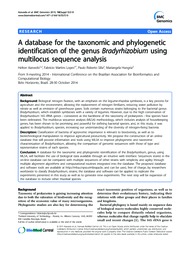A database for the taxonomic and phylogenetic identification of the genus Bradyrhizobium using multilocus sequence analysis.
A database for the taxonomic and phylogenetic identification of the genus Bradyrhizobium using multilocus sequence analysis.
Autoria: AZEVEDO, H.; LOPES, F. M.; SILLA, P. R.; HUNGRIA, M.
Resumo: Biological nitrogen fixation, with an emphasis on the legume-rhizobia symbiosis, is a key process for agriculture and the environment, allowing the replacement of nitrogen fertilizers, reducing water pollution by nitrate as well as emission of greenhouse gases. Soils contain numerous strains belonging to the bacterial genus Bradyrhizobium, which establish symbioses with a variety of legumes. However, due to the high conservation of Bradyrhizobium 16S rRNA genes - considered as the backbone of the taxonomy of prokaryotes - few species have been delineated. The multilocus sequence analysis (MLSA) methodology, which includes analysis of housekeeping genes, has been shown to be promising and powerful for defining bacterial species, and, in this study, it was applied to Bradyrhizobium, species, increasing our understanding of the diversity of nitrogen-fixing bacteria. Description: Classification of bacteria of agronomic importance is relevant to biodiversity, as well as to biotechnological manipulation to improve agricultural productivity. We propose the construction of an online database that will provide information and tools using MLSA to improve phylogenetic and taxonomic characterization of Bradyrhizobium, allowing the comparison of genomic sequences with those of type and representative strains of each species. Conclusion: A database for the taxonomic and phylogenetic identification of the Bradyrhizobium, genus, using MLSA, will facilitate the use of biological data available through an intuitive web interface. Sequences stored in the on-line database can be compared with multiple sequences of other strains with simplicity and agility through multiple alignment algorithms and computational routines integrated into the database. The proposed database and software tools are available at http://mlsa.cnpso.embrapa.br, and can be used, free of charge, by researchers worldwide to classify Bradyrhizobium, strains; the database and software can be applied to replicate the experiments presented in this study as well as to generate new experiments. The next step will be expansion of the database to include other rhizobial species.
Ano de publicação: 2015
Tipo de publicação: Artigo de periódico
Unidade: Embrapa Soja
Palavras-chave: Fixação de nitrogênio, Nitrogen fixation
Observações
1 - Por padrão são exibidas publicações dos últimos 20 anos. Para encontrar publicações mais antigas, configure o filtro ano de publicação, colocando o ano a partir do qual você deseja encontrar publicações. O filtro está na coluna da esquerda na busca acima.
2 - Para ler algumas publicações da Embrapa (apenas as que estão em formato ePub), é necessário ter, no celular ou computador, um desses softwares gratuitos. Sistemas Android: Google Play Livros; IOS: iBooks; Windows e Linux: software Calibre.
Acesse outras publicações
Acesse a Base de Dados da Pesquisa Agropecuária (BDPA) para consultar o acervo completo das bibliotecas da Embrapa.

